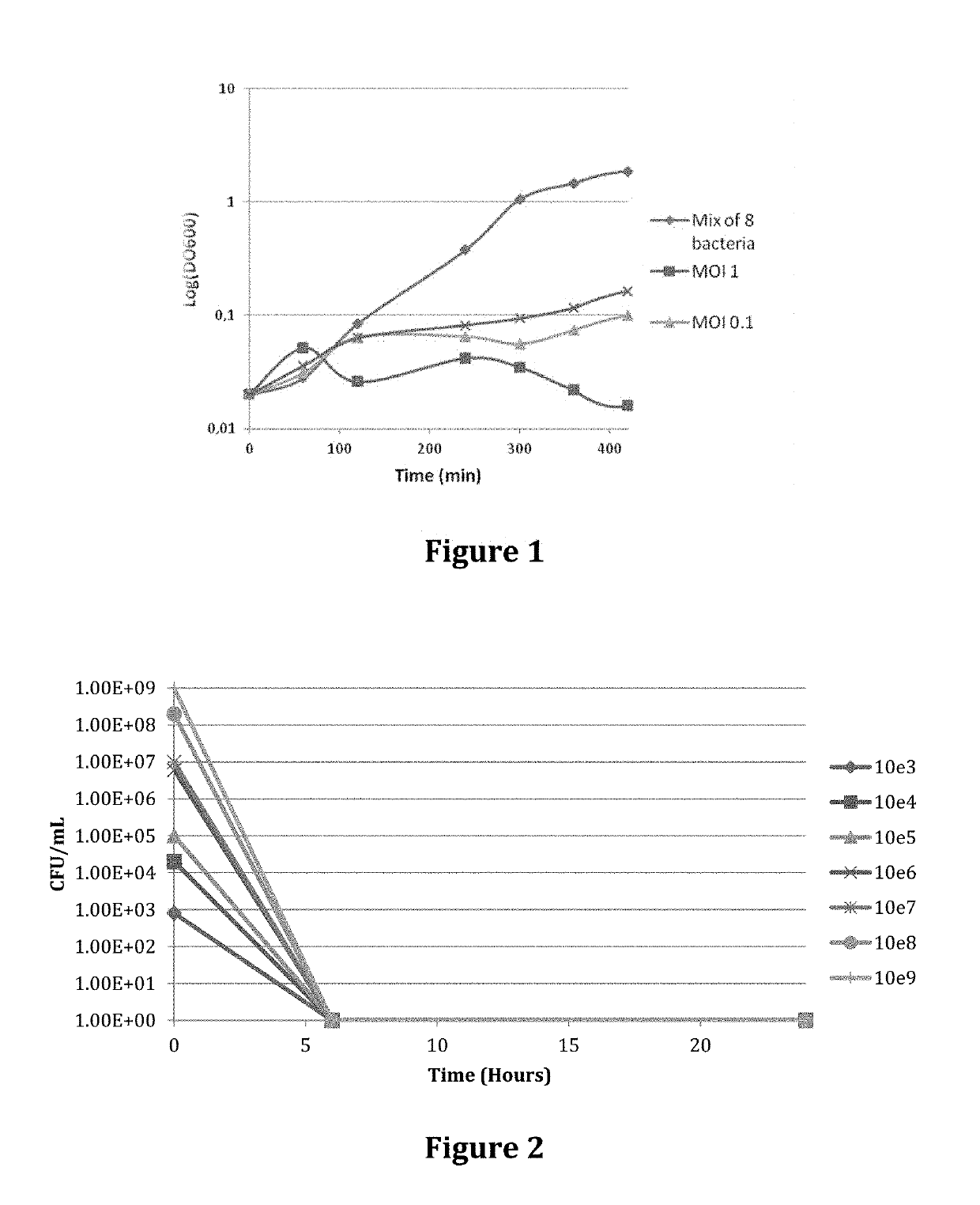Phage therapy of Pseudomonas infections
a phage and pseudomonas technology, applied in the field of phage therapy of i > pseudomonas /i > infections, can solve the problems of high controversy, lack of appropriate control, inconsistent early studies, etc., and achieves the effects of modifying the balance of microbial activity, strong lytic activity, and high selectivity
- Summary
- Abstract
- Description
- Claims
- Application Information
AI Technical Summary
Benefits of technology
Problems solved by technology
Method used
Image
Examples
example 1
hage-Host Characteristics and Kinetics
[0149]One-step growth experiments were carried out according to the previous descriptions to determine first the productive lytic time, adsorption rate then the phage burst size. To determine the adsorption rate samples were taken at different time intervals to analyze the free phage particles in the solutions. For productive time and phage burst size determination, P. aeruginosa bacteria were mixed with phage solutions and phages were allowed to adsorb for 15 min. The mixture was subjected to centrifugation immediately at 5000 rpm for 10 min to remove free phage particles. The pellet was resuspended in 5 fresh LB medium and the culture was continuously incubated at 37° C. Samples were taken at 3 min intervals and phage titre was determined. These results permitted to calculate the number of phages produced per bacteria (burst size), the productive time and the productive lytic effect (PLE), as shown in Table 5 below.
[0150]
TABLE 4PLEProductiveBU...
example 2
on of Cocktail Compositions
[0152]The following cocktail compositions are constituted, each comprising between 10-9 and 10-11 pfu of each bacteriophage:
[0153]
TABLE 5CocktailPhagesIP1384 + P1433IIP1384 + P1450IIIP1430 + P1649IVP1430 + P1433VP1430 + P1650VIP1384 + P1430 + P1433VIIP1384 + P1430 + P1450VIIIP1384 + P1430 + P1649
[0154]The following additional two cocktail compositions comprising all of the various phages are constituted, covering the most important diversity of P. aeruginosa species:
[0155]
Cocktail composition A:Phage13841429143014331450164416471648titer4.00E+101.23E+095.45E+088.33E+108.91E+109.09E+082.00E+093.09E+09Phage16491650165816611662Titre9.00E+099.45E+081.91E+091.14E+093.55E+08
[0156]
Cocktail composition B:phage13841429143014331450164416471648Titre1.60E+112.00E+112.00E+111.20E+118.00E+101.00E+111.00E+081.00E+09phage16491650165816611662Titre1.00E+112.20E+118.00E+101.00E+116.00E+07
example 3
ty of Bacteria to Bacteriophage Cocktails of the Invention
[0157]Various strains of bacteria were tested with the bacteriophage cocktails of the invention at 2.109 bacteriophages / ml. Different bacterial concentrations were plated on the bacteriophage cocktail at 2.109 bacteriophages / ml and incubated 24 h at 37° C.
[0158]Cocktails are tested on the 22 distinct P. aeruginosa bacteria listed in Tables 2 and 3. The % of bacteria species sensitive to the cocktails are listed in Table 6 below:
[0159]
TABLE 6Cocktail% Killed P. aeruginosa speciesI73%II82%III91%IV86%V77%VI86%VII95%VIII95%A100% B100%
[0160]Bacteria were enumerated and used to the calculation of resistance rate (number of bacteria after incubation / number of bacteria plated). Resistance rates with a cocktail comprising the 13 different types of bacteriophages are shown in Table 7 below:
[0161]
TABLE 7BacteriaRate (bacteria / ml)LMG 248911.00E−05LMG 249455.80E−06LMG 249701.00E−05LMG 250824.60E−06LMG 251319.00E−06LMG 251949.00E−06
[0162]...
PUM
| Property | Measurement | Unit |
|---|---|---|
| Fraction | aaaaa | aaaaa |
| Fraction | aaaaa | aaaaa |
| Fraction | aaaaa | aaaaa |
Abstract
Description
Claims
Application Information
 Login to View More
Login to View More - R&D
- Intellectual Property
- Life Sciences
- Materials
- Tech Scout
- Unparalleled Data Quality
- Higher Quality Content
- 60% Fewer Hallucinations
Browse by: Latest US Patents, China's latest patents, Technical Efficacy Thesaurus, Application Domain, Technology Topic, Popular Technical Reports.
© 2025 PatSnap. All rights reserved.Legal|Privacy policy|Modern Slavery Act Transparency Statement|Sitemap|About US| Contact US: help@patsnap.com


